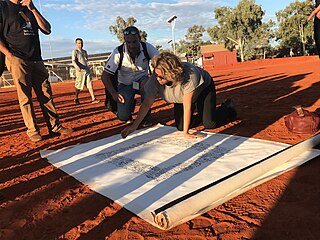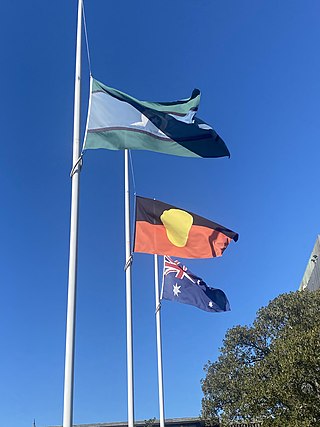
Mabo v Queensland is a landmark decision of the High Court of Australia that recognised the existence of Native Title in Australia. It was brought by Eddie Mabo and others against the State of Queensland, and decided on 3 June 1992. The case is notable for being the first in Australia to recognise pre-colonial land interests of Indigenous Australians within the common law of Australia.
Native title is the set of rights, recognised by Australian law, held by Aboriginal and Torres Strait Islander groups or individuals to land that derive from their maintenance of their traditional laws and customs. These Aboriginal title rights were first recognised as a part of Australian common law with the decision of Mabo v Queensland in 1992. The doctrine was subsequently implemented and modified via statute with the Native Title Act 1993.

Commonwealth v Tasmania was a significant Australian court case, decided in the High Court of Australia on 1 July 1983. The case was a landmark decision in Australian constitutional law, and was a significant moment in the history of conservation in Australia. The case centred on the proposed construction of a hydro-electric dam on the Gordon River in Tasmania, which was supported by the Tasmanian government, but opposed by the Australian federal government and environmental groups.

Camp Sovereignty is the name given to an Aboriginal and Torres Strait Islander protest movement established as part of the "Black GST" political movement. GST stands for ending genocide, acknowledging sovereignty and securing treaty. The camp has existed as two iterations, one in March 2006 and one in January 2024.
Indigenous Australian self-determination, also known as Aboriginal Australian self-determination, is the power relating to self-governance by Aboriginal and Torres Strait Islander peoples in Australia. It is the right of Aboriginal and Torres Strait Islander peoples to determine their own political status and pursue their own economic, social and cultural interests. Self-determination asserts that Aboriginal and Torres Strait Islander peoples should direct and implement Aboriginal and Torres Strait Islander policy formulation and provision of services. Self-determination encompasses both Aboriginal land rights and self-governance, and may also be supported by a treaty between a government and an Indigenous group in Australia.

Kevin Buzzacott, often referred to as Uncle Kev, was an Aboriginal Australian rights campaigner and elder of the Arabunna nation in northern South Australia. He campaigned widely for cultural recognition, justice, and land rights for Aboriginal people. He initiated and led numerous campaigns, including against uranium mining at Olympic Dam mine on Kokatha land and the exploitation of the water from the Great Artesian Basin. He also published a collections of poetry, which included the content of his keynote address at a 1998 conference.
Indigenous Australians are people with familial heritage from, and/or recognised membership of, the various ethnic groups living within the territory of present day Australia prior to British colonisation. They consist of two distinct groups, which include many ethnic groups: the Aboriginal Australians of the mainland and many islands, including Tasmania, and the Torres Strait Islanders of the seas between Queensland and Papua New Guinea, located in Melanesia.
Indigenous Australian customary law or Indigenous Australian customary lore refers to the legal systems and practices uniquely belonging to Indigenous Australians of Australia, that is, Aboriginal and Torres Strait Islander people.

The Aboriginal Provisional Government (APG) is an Indigenous Australian independence movement in Australia.

The National Congress of Australia's First Peoples was the national representative body for Aboriginal and Torres Strait Islander Australians from 2009 to 2019.
In Australia, Indigenous land rights or Aboriginal land rights are the rights and interests in land of Aboriginal Australians and Torres Strait Islander people; the term may also include the struggle for those rights. Connection to the land and waters is vital in Australian Aboriginal culture and to that of Torres Strait Islander people, and there has been a long battle to gain legal and moral recognition of ownership of the lands and waters occupied by the many peoples prior to colonisation of Australia starting in 1788, and the annexation of the Torres Strait Islands by the colony of Queensland in the 1870s.

Lidia Alma Thorpe is an Aboriginal Australian independent politician. She has been a senator for Victoria since 2020 and is the first Aboriginal senator from that state. She was a member of the Australian Greens until February 2023, when she quit the party over disagreements concerning the proposed Indigenous Voice to Parliament, and became a "key" figure in the "progressive No" campaign for the Voice referendum in October 2023. Thorpe served as the Greens' deputy leader in the Senate from June to October 2022.

The Uluru Statement from the Heart is a 2017 petition to the people of Australia, written and endorsed by the Australian Aboriginal and Torres Strait Islander leaders selected as delegates to the First Nations National Constitutional Convention. The document calls for substantive constitutional change and structural reform through the creation of two new institutions; a constitutionally protected First Nations Voice and a Makarrata Commission, to oversee agreement-making and truth-telling between governments and First Nations. Such reforms should be implemented, it is argued, both in recognition of the continuing sovereignty of Indigenous peoples and to address structural power differences that has led to severe disparities between Indigenous and non-Indigenous Australians. These reforms can be summarised as Voice, Treaty and Truth.

The Aboriginal and Torres Strait Islander Voice, also known as the Indigenous Voice to Parliament, the First Nations Voice or simply the Voice, was a proposed Australian federal advisory body to comprise Aboriginal and Torres Strait Islander people, to represent the views of Indigenous communities.

Reconciliation in Australia is a process which officially began in 1991, focused on the improvement of relations between the Aboriginal and Torres Strait Islander peoples of Australia and the rest of the population. The Council for Aboriginal Reconciliation (CAR), created by the government for a term of ten years, laid the foundations for the process, and created the peak body for implementation of reconciliation as a government policy, Reconciliation Australia, in 2001.
Constitutional recognition of Indigenous Australians refers to various proposals for changes to the Australian Constitution to recognise Indigenous Australians in the document. Various proposals have been suggested to symbolically recognise the special place Indigenous Australians have as the first peoples of Australia, along with substantial changes, such as prohibitions on racial discrimination, the protection of languages and the addition of new institutions. In 2017, the Uluru Statement from the Heart was released by Indigenous leaders, which called for the establishment of an Indigenous Voice to Parliament as their preferred form of recognition. When submitted to a national referendum in 2023 by the Albanese government, the proposal was heavily defeated.

Robert Thorpe is an Aboriginal Australian activist and presenter of Fire First, a program on community radio station 3CR in Melbourne.

The 2023 Australian Indigenous Voice referendum was a constitutional referendum held on 14 October 2023 in which the proposed Aboriginal and Torres Strait Islander Voice was rejected. Voters were asked to approve an alteration to the Australian Constitution that would recognise Indigenous Australians in the document through prescribing a body called the Aboriginal and Torres Strait Islander Voice that would have been able to make representations to Federal Parliament and the executive government on "matters relating to Aboriginal and Torres Strait Islander peoples". The proposal was rejected nationally and by a majority in every state, thus failing to secure the double majority required for amendment by section 128 of the constitution. The Australian Capital Territory was the only state or territory with a majority of "yes" votes. Analysis of surveys following the referendum identified the main reasons why the majority of Australians voted no was a scepticism of rights for some Australians that are not held by others and a fear of constitutional change.
Australian Indigenous advisory bodies are Aboriginal and Torres Strait Islander advisory bodies established or proposed to be established by the Commonwealth and state and territory governments. Calls for such bodies, especially for a Commonwealth level Voice to Parliament, became prominent following the release of the Uluru Statement from the Heart, however similar bodies of various levels of independence have existed since the official end of assimilationist policies in the 1970s and the promotion of self-determination and reconciliation. Such bodies generally advise governments on policies and programmes that affect Indigenous Australians, and represent Indigenous interests in public debate. Other advisory bodies have been established in the context of state treaty process, to advise governments and Indigenous groups to prepare for upcoming negotiations.











